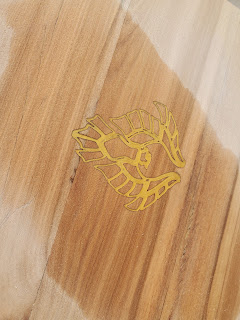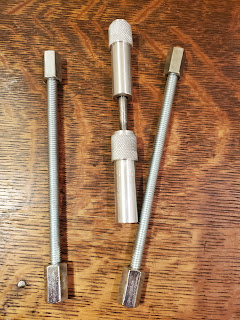Disclaimer - I absolutely know the KrakenSDR is intended for coherent radio work such as directional analysis. I absolutely know I am abusing the intent, and that I could use other equipment (or time) to do this work. Queue ominous music here... I thought that nothing else I have would give me access to monitor 5 channels at once, so this becomes one of the best options out there.
In our local neighborhood, we've had an emergency radio network. This isn't for amateur radio operators (HAM's), and is much more broad. We use hand held GMRS radios for emergency communications, and for monthly network checks.
Now, we've had this radio network working for a few decades or so, and the last few years have been fraught with interference from other operators who are pushing frequencies beyond what I thought they should.
We've had an assigned frequency to use (channel 21, or 462.7 MHz) that is just getting pummeled lately by interference. We'd squash one, and another "abuse" would crop up. It was at this time I found out that the FCC has changed the rules. Channels 15-22 are no longer restricted to 5 watt systems. They are now only restricted to 50 watt systems, meaning you are allowed to push these MUCH further than you could before. NOW the interference all makes sense.
I also learned today that the city doesn't really care what frequency or channel we use - we need to make sure we can communicate, and we need to use a different GMRS channel that doesn't have the interference, and one that doesn't cause interference around us. Enter the Kraken(SDR), er, enter the Dragon(OS).
Normally, equipment like this is used for fox hunting and other coherent applications (directional analysis is a big player). I have a KrakenSDR, and it has been set up for fox hunting. I have a completely mobile rig I can throw into my vehicle, slap the antenna on top, and be off.
But, since we're pinned to GMRS channels, and looking for the lowest power output channels we can find in order to not have more likelihood of interference, we're settling on channels 8 through 14. So, why not load the KrakenSDR up and take it for a monitoring spin?
I normally just use the Raspberry Pi, but I rationalized using a different installation here (an old 32 core desktop computer hooked up to some monitors), so I grabbed a download for DragonOS and installed it. The desktop has sat idle for a few years (four to be exact) after being used as a virtual server lab for work, and I was getting ready to just turn it back in to the office, so I figured, why not?
First, making sure I could plug the KrakenSDR in and making sure it connected was the focus (running cables, etc). I wouldn't know for sure that I got it all set up right until we get the first runs at this, so at this point, I was still running blind.
My next order of business was to get the right application running that included the waterfall. On the Mac, I'd normally go with SmartSDR, but that was not installed on DragonOS. So, I punted and went with CubicSDR. it is essentially the same thing, and it is installed.
Considering I had five separate radios, I loaded up 5 instances of CubicSDR (one for each channel).
It was at this time that I realized every time I broadcast on the radio, it threw some serious chatter out (these Motorola hand held FRS radios are terrible - there are harmonics all over I didn't know were there - they are leaps and bounds worse than the Baofeng UV-5R radios), and that I could see ALL of the channels I was interested in across the entire spectrum on one display. I closed the other CubicSDR windows and went with a single one.
Suddenly, I remembered my old RTL-SDR days, and had a few "well, duh!" moments. Knowing I could adjust the spectrum and see all channels in one was one of these.
I defined all channels (8 through 14) in my bookmarks on the left side (they are called "modem", or a modulator/demodulator).
| Channel | Frequency | Use | Bandwidth | Max Watts |
|---|---|---|---|---|
| 1 | 462.5625 MHz | GMRS/FRS | 20 kHz | 5 W |
| 2 | 462.5875 MHz | GMRS/FRS | 20 kHz | 5 W |
| 3 | 462.6125 MHz | GMRS/FRS | 20 kHz | 5 W |
| 4 | 462.6375 MHz | GMRS/FRS | 20 kHz | 5 W |
| 5 | 462.6625 MHz | GMRS/FRS | 20 kHz | 5 W |
| 6 | 462.6875 MHz | GMRS/FRS | 20 kHz | 5 W |
| 7 | 462.7125 MHz | GMRS/FRS | 20 kHz | 5 W |
| 8 | 467.5625 MHz | FRS | 12.5 kHz | 0.5 W |
| 9 | 467.5875 MHz | FRS | 12.5 kHz | 0.5 W |
| 10 | 467.6125 MHz | FRS | 12.5 kHz | 0.5 W |
| 11 | 467.6375 MHz | FRS | 12.5 kHz | 0.5 W |
| 12 | 467.6625 MHz | FRS | 12.5 kHz | 0.5 W |
| 13 | 467.6875 MHz | FRS | 12.5 kHz | 0.5 W |
| 14 | 467.7125 MHz | FRS | 12.5 kHz | 0.5 W |
| 15 | 462.550 MHz | GMRS/FRS | 20 kHz | 50 W |
| 16 | 462.575 MHz | GMRS/FRS | 20 kHz | 50 W |
| 17 | 462.600 MHz | GMRS/FRS | 20 kHz | 50 W |
| 18 | 462.625 MHz | GMRS/FRS | 20 kHz | 50 W |
| 19 | 462.650 MHz | GMRS/FRS | 20 kHz | 50 W |
| 20 | 462.675 MHz | GMRS/FRS | 20 kHz | 50 W |
| 21 | 462.700 MHz | GMRS/FRS | 20 kHz | 50 W |
| 22 | 462.725 MHz | GMRS/FRS | 20 kHz | 50 W |
Then, I activated all 7 channels, and zoomed in on the spectrum I wanted to monitor (you can do that using the mouse scroll wheel on the frequency chart above the main waterfall).
I noticed one of them appeared irregularly placed (attention to detail will do that to a guy), and indeed, I was 50 kHz off on the frequency center. Not really a problem - I just need to see the windows of what broadcast.. Still, I fixed it, because my attention to detail would have irritated me. Yes, there are two broadcasts on the screen shot above - one is on channel 8 (467.5625 MHz) and the other is on channel 14 (467.7125 MHz). I did that so I could have my book ends and see the entire range for all channels.
I adjusted the waterfall rate so that it was about 10 minutes of historical data.
Then, in a fit of absolute laziness, I changed it to about a minute and a half, and then scheduled a cron. DragonOS includes ImageMagick, and that means it has command-line-based screen capture tools. So, I created a quick shell script :
#!/bin/bash
DATE=`/usr/bin/date +%s`
/usr/bin/import -display :0.0 -window root /home/bubba/frenquency_watch-$DATE.jpg > /home/bubba/screen.log 2>&1
And then I created my cron entry :
* * * * * /home/bubba/run.sh > /dev/null 2>&1This forced a screen shot every minute while I was running my scan. I could simply scroll through the images and see anything that jumped out at me. Hooray for laziness! I could walk away, not store hours of audio that I'd have to scan through, and I wouldn't have to sit by a computer for hours on end, my eyes pinned to a screen watching for blips on the proverbial radar.
With the active modem's (or channels) shown on screen, I had a great indicator at each minute of when something was broadcasting, which included the entire previous minute.
Mid way through the scanning session window I wanted to proof out, I ran a few tests just to see. Not being able to remember which channel I ran the test on, I could look at the screen and see :
That showed me I was on channel 14. Sweet! It works!
After finishing the scan for the entire evening to see if other neighborhoods are also using the frequency, I could scan through any images showing an anomaly like the above, and....
It looks like there was an out-of-band (higher than channel 14) at 7:00 PM (my time was 33 minutes off - I didn't care), and something was playing on channel 10 for a brief blip around 9:03 PM.
With the harmonics (probably won't do much) showing interference on channels 10 and 12 (it is, frankly, not enough to worry about - but I'm so wanting to clear these channels for the neighborhood that I'm eliminating 12, too), in addition to that brief blip just outside of 14, it looks like we can use 8, 11, and 13. channel 9 was just a little too close to the harmonics for comfort.
Now we can lay claim to any of these clear FRS channels for the emergency preparedness work we do as a neighborhood.




























































